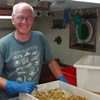General Description
Head wider than long; rostrum broad, rounded-truncate, longer than anterolateral lobes. Pereon with 2 pairs of low carinae dorsally, separated by deep pitted grooves. Palm of first leg on axis of limb.
Biology
This isopod is an active predator that uses its hook-like hands to grasp its prey and its biting mouthparts to make a meal of it. Males have longer antennae and larger eyes than juveniles or females and can swim in search of mates. The Anthuridae and similar families are common and diverse on sandy and muddy sediments and can build tubes.
Habitat
Clayey-silt sediment, at depths of 3-293 m
Reefs
Distribution guide
Southern Australia.
Species Group
Depth
Shallow (1-30 m)
Deep ( > 30 m)
Water Column
Max Size
10 mm
Diet
Organic matter
Commercial Species
No
Global Dispersal
Recorded in Australia
Species Code
MoV 338
Conservation Status
- DSE Advisory List : Not listed
- EPBC Act 1999 : Not listed
- IUCN Red List : Not listed






